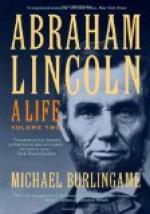In the condition of feeling during the months in which these events were occurring, they undeniably subjected the government to a very severe strain. They furnished the Democrats with ammunition far better than any which they had yet found, and they certainly used it well. Since the earliest days of the war there had never been quite an end of the protestation against arbitrary military arrests and the suspension of the sacred writ of habeas corpus, and now the querulous outcry was revived with startling vehemence. Crowded meetings were held everywhere; popular orators terrified or enraged their audiences with pictures of the downfall of freedom, the jeopardy of every citizen; resolutions and votes without number expressed the alarm and anger of the great assemblages; learned lawyers lent their wisdom to corroborate the rhetoricians, and even some Republican newspapers joined the croaking procession of their Democratic rivals. Erelong the assaults appeared to be producing effects so serious and widespread that the President was obliged to enter into the controversy. On May 16 a monster meeting of “the Democrats of New York” was told by Governor Seymour that the question was: “whether this war is waged to put down rebellion at the South, or to destroy free institutions at the North.” Excited by such instigation, the audience passed sundry damnatory resolutions and sent them to the President.
Upon receiving these, Mr. Lincoln felt that he must come down into the arena, without regard to official conventionality. On June 12 he replied by a full presentation of the case, from his point of view. He had once more to do the same thing in response to another address of like character which was sent to him on June 11 by the Democratic State Convention of Ohio. In both cases the documents prepared by the remonstrants were characterized, to more than the usual degree, by that dignified and ore rotundo phraseology, that solemnity in the presentation of imposing generalities, which are wont to be so dear to committees charged with drafting resolutions. The replies of the President were in striking contrast to this rhetorical method alike in substance and in form; clear, concise, and close-knit, they were models of good work in political controversy, and like most of his writing they sorely tempt to liberal transcription, a temptation which must unfortunately be resisted, save for a few sentences. The opening paragraph in the earlier paper was cleverly put:—
“The resolutions are resolvable into two propositions,—first, the expression of a purpose to sustain the cause of the Union, to secure peace through victory, and to support the administration in every constitutional and lawful measure to suppress the rebellion; and, secondly, a declaration of censure upon the administration for supposed unconstitutional action, such as the making of military arrests. And, from the two propositions, a third is deduced, which is, that the




